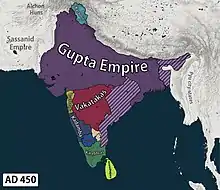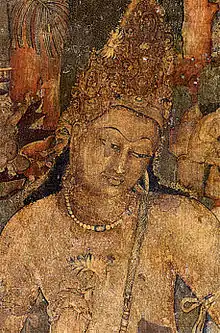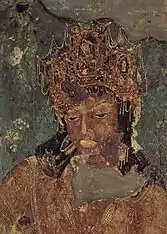Narendrasena
Narendrasena was a powerful Vakataka king. He was the son of Pravarasena II, and emerged the victor in a succession struggle following his father's death.[1] He reigned c. 440 – 460 and was succeeded by his son Prithvishena II.[2]
| Narendrasena | |
|---|---|
 | |
| Reign | c. 440 – 460 |
| Predecessor | Pravarasena II |
| Successor | Prithvishena II |
| Spouse | Ajihata Bhattarika |
| Issue | Prithvishena II |
| Dynasty | Vakataka |
| Vakataka dynasty 250–500 CE | |
 |
 |
| Vindhyashakti | (250–270) |
| Pravarasena I | (270–330) |
| Pravarapura–Nandivardhana branch | |
| Rudrasena I | (330–355) |
| Prithivishena I | (355–380) |
| Rudrasena II | (380–385) |
| Prabhavatigupta (regent) | (385–405) |
| Divakarasena | (385–400) |
| Damodarasena | (400–440) |
| Narendrasena | (440–460) |
| Prithivishena II | (460–480) |
| Vatsagulma branch | |
| Sarvasena | (330–355) |
| Vindhyasena | (355–400) |
| Pravarasena II | (400–415) |
| Unknown | (415–450) |
| Devasena | (450–475) |
| Harishena | (475–500) |
Early life
From the Balghat inscription of inscription of Pravarasena II, we come to know that Pravarasena II entered into a matrimonial alliance with the contemporary Kadambas. Narendrasena was married to Ajihata Bhattarika, the daughter of Kakusthavarma of the Kadamba dynasty.[3][4][5][6][7] [8]Pravarasena II's death was probably followed by a succession struggle from which Narendrasena, his son emerged as the victor.[1][2]
Reign
When the Guptas became involved in a war against the Huna invaders, the Vakatakas were free to expand in central India.[9] Narendrasena spread the Vakataka influence to Kosala, Mekala, and Malava. This however, ultimately brought the Vakatakas into conflict with the Nalas of Dakshina Kosala and caused a setback to the Vakataka family.[9] Narendrasena was succeeded by his son, Prithvishena II, who revived the Vakataka power for a short time.[9]
References
- Singh, Upinder (2009). A history of ancient and early medieval India : from the Stone Age to the 12th century. New Delhi: Pearson Longman. pp. 482–484. ISBN 978-81-317-1677-9. Retrieved 10 August 2016.
- "Narendrasena: 1 definition". Wisdomlib. Wisdomlib. Retrieved 26 January 2021.
- Kamath, S.U. (1980), p. 33
- Sastri (1955), p. 101
- Sen (1999), p. 468
- Sen (1999), p. 244
- Majumdar (1986), p.240
- {{cite web |title=Which of the following Kings entered into a matrimonial alliance with the contemporary Kadambas? |url=https://www.gktoday.in/question/which-of-the-following-kings-entered-into-a-matrim |website=GK Today |publisher=GK Today |access-date=26 January 2021
- "Vakataka dynasty | Indian history | Britannica". Britannica. Britannica. Retrieved 26 January 2021.
Sources
- Kamath, Suryanath U. (2001) [1980]. A Concise history of Karnataka from pre-historic times to the present. Bangalore: Jupiter Books. OCLC 7796041.
- Sastri, Nilakanta K.A. (2002) [1955]. A history of South India from prehistoric times to the fall of Vijayanagar. New Delhi: Indian Branch, Oxford University Press. ISBN 0-19-560686-8.
- Sen, Sailendra Nath (1999) [1999]. Ancient Indian History and Civilization. New Age Publishers. ISBN 81-224-1198-3.
- Majumdar & Altekar, Ramesh Chandra & Ananth Sadashiv (1986) [1986]. Vakataka - Gupta Age Circa 200-550 A.D. New Delhi: Motilal Banarasidass Publications. ISBN 81-208-0026-5.